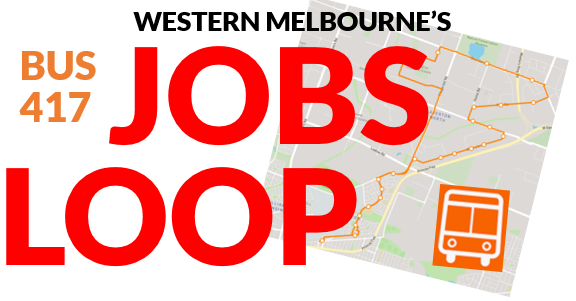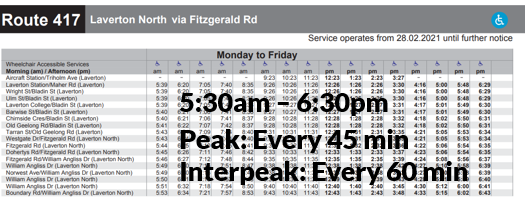Serving no homes that other bus routes also don't serve, the 417 is an unusual bus service in Melbourne. A bit like the Fishermans Bend routes it is an industrial service. It connects Laverton Station with the vast light industrial area of Laverton North. In this it is like other routes from Laverton like 400 and 414, but it has significant unique coverage those routes don't cover.
Route 417 is a clockwise loop as you can see below. It needs one bus to get from Laverton to Laverton. This takes 45 minutes which is also the route's peak frequency. The loop means that travel times vary for those going to jobs near the start or end of the loop with backtracking sometimes encountered.
Patronage
Industrial bus routes sometimes have a poor reputation in some CBD-based planning circles. The latter, with their postgraduate degrees and homes within earshot of a tram ding, could not be more socio-economically different to 'working poor' suburbanites on the buses.
It is sometimes thought that with some jobs requiring drivers licences, high car ownership, and universal free parking it would be futile to run buses to industrial areas. At best a few apprentices might use them, quitting as soon as they can afford a car.
A largely industrial route on the other side of Melbourne, the 890 from Dandenong to Lynbrook, gives hope. It gets 25 passenger boardings per bus service hour on weekdays. This is higher than the 20 boardings per hour minimum that Infrastructure Victoria regards as constituting a viable route. And it's very close to average for buses in Melbourne, nearly all of which serve residential areas. Non-school days is only slightly less at 24 boarding per hour on weekdays. Hence you can run buses through industrial areas and have people use them. The weekday numbers indicate 890's worth. I said more about 'job ready' public transport networks with improved service to industrial areas here.
417's future as part of a bigger network
In 2010, when the 417 started, the population of places like Point Cook and Tarneit was lower than today. There were no stations at Williams Landing or Tarneit. Sunshine was less of a hub as the Regional Rail Link had not been built. And the residential population of suburbs like Truganina was a fraction of today's.
Hence, in 2010, if you were going to put in a 'smell of an oily rag' industrial route for Laverton North and only had one bus to use the logical choice would have been to depart it from Laverton Station. Which is what they did. Then people could catch it after coming off trains from Werribee.
An issue here is that most of Wyndham lives beyond walking distance of Werribee line stations. Unless you were lucky with connections a bus - train - bus trip would involve a lot of waiting given the 417's 45 minute peak frequency.
If you were designing an industrial area network for Laverton North in 2021 you wouldn't do it like was done in 2010. You would definitely have connections to Tarneit and likely Williams Landing. Such routes could serve residential areas so that some people wouldn't need to change buses while many others would have just one connection. Cutting out transfers is a massive time-saver where routes are infrequent. It also makes efficient network planning if you can do it without overlapping multiple routes on long corridors that don't need them.
As well you might have linear routes that instead of doing a loop would run straight through to another important terminus like Sunshine. That way the population with a one-change connection to an industrial area bus would double if not more. And there may even be enough demand to run a basic weekend through service, such as currently operates on Route 400. A concept for a more 'job ready' network is mapped below.
 |
Such a network appears more affordable now than before with recent growth presenting opportunities. Residential development at Truganina has edged closer and closer to the industrial area. Tarneit Station is now a large bus hub with many bus routes today and more being planned.
One of those funded (the 154) is a bus that goes to the edge of the Laverton North industrial area from Tarneit Station. Even if only done on weekdays, there may be scope to extend trips on this route deeper into the Laverton North jobs area. Connecting with a significant hub the other side could assist with some non-industrial trips as well. The busy interchange of Sunshine looks the front-runner but Altona Gate or even Laverton (merging with the 417) may also be possibilities. A proper implementation would likely involve a rethink of Route 417 and likely also 400 and 414 to provide a simpler and more connected network.
Another opportunity for the 417 (or some other local route such as the 414) is presented by the removal of the level crossing near Aircraft Station. In the distant past buses connected Bladin St north of the line with Central Square shops south of the line. However as train and car traffic increased this connection was severed with separate routes north and south of the railway (likely superior for operational reliability). However there may be scope to restore this connection to improve Bladin St's access to local shopping. The economy of this depends on whether the extra run times can be accommodated without increasing the bus requirement.
Conclusion
What are your thoughts of the 417? Should it remain as is or is there scope for a rethink given the growth of surrounding areas? Does its timetable suit jobs in the area? And is it a good idea to try to combine industrial and residential routes? Comments are appreciated and can be left below.







No comments:
Post a Comment